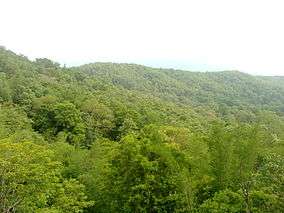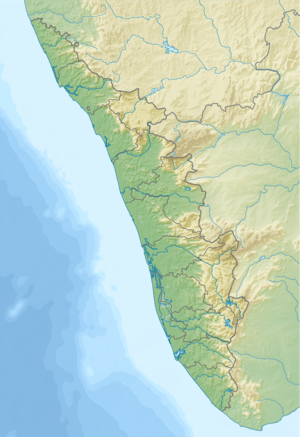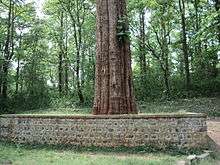Parambikulam Tiger Reserve
Parambikulam Tiger Reserve, which also includes the erstwhile Parambikulam Wildlife Sanctuary, is a 391 square kilometres (151.0 sq mi)[2] protected area in Kollengode Block, Chittur taluk in Palakkad district of Kerala state, South India. The wildlife sanctuary, which had an area of 285 square kilometres (110 sq mi) was established in 1973. It is in the Sungam range of hills between the Anaimalai Hills and Nelliampathy Hills.[3][4][5] Parambikulam Wildlife Sanctuary was declared as part of the Parambikulam Tiger Reserve on 19 February 2010.[6][7][8] Including the buffer zone, the tiger reserve has a span of 643.66 km2. The Western Ghats, Anamalai Sub-Cluster, including all of Parambikulam Wildlife Sanctuary, is under consideration by the UNESCO World Heritage Committee for selection as a World Heritage Site.[9] The sanctuary is the home of four different tribes of indigenous peoples including the Kadar, Malasar, Muduvar and Mala Malasar settled in six colonies. Parambikulam Tiger Reserve implements the Participatory Forest Management Scheme (PFMS). People from tribal colonies inside the reserve are engaged as guides for treks and safaris, and are provided employment through various eco-tourism initiatives.[10][11] The tiger reserve hosts many capacity building training programmes conducted by Parambikulam Tiger Conservation Foundation in association with various organisations.[12]
| Parambikulam Tiger Reserve പറമ്പിക്കുളം കടുവാസങ്കേതം | |
|---|---|
IUCN category IV (habitat/species management area) | |
 Parambikulam Tiger Reserve | |
  | |
| Location | Kollengode Block, Chittur Taluk, Palakkad District, Kerala, India |
| Nearest city | Palakkad (90 km)[1] |
| Coordinates | 10°23′0″N 76°42′30″E |
| Area | 285 square kilometres (110 sq mi) |
| Established | 1973 |
| Visitors | 86000 |
| Governing body | Kerala Forest Dept. Vysak Sasikumar IFS, Deputy Director (Project Tiger) |
| Website | www |
Template:Protected area
Geography
The sanctuary is located between Longitude:76° 35’- 76° 50’ E, and Latitude:10° 20’ – 10° 26’ N. It is 135 kilometres (84 mi) from Palakkad town and adjacent to the Annamalai Wildlife Sanctuary to the east in Tamil Nadu. It is bordered to the north by Nemmara Forest Division, to the south by Vazhachal Forest Division and the west by Chalakudy Forest Division. The sanctuary has a hornblende, biotite, gneiss and charnockite geology.
Altitude ranges between 300 m and 1438 m. There is a 600 m elevation opening through the Nelliampathy hills from Anamalai hills on the northern boundary of the sanctuary at Thoothampara. Major peaks in the sanctuary are Karimala Gopuram (1438 m) in the southern boundary of the sanctuary, Pandaravarai (1290 m) in the north, Kuchimudi, Vengoli Malai (1120 m) in the eastern boundary and Puliyarapadam (1010 m) in the west.
The sanctuary has three man-made reservoirs; Parambikulam, Thunacadavu (Thunakkadavu) and Peruvaripallam, with a combined area of 20.66 km2. The Thuvaiar water falls empty into one of the reservoirs. There are 7 major valleys and 3 major rivers, the Parambikulam, the Sholayar and the Thekkedy. The Karappara river and Kuriarkutty river also drain the area.
History
The tiger reserve has remnants of the Cochin State Forest Tramway, which was used to ship wood from the Parambikulam forests to the nearby harbor at Kochi, and from there to different locations of the world.
Visitor information


Ecotourism activities at the tiger reserve are held at the buffer zones of the tiger reserve, avoiding the core areas.[13] Parambikulam provides visitors with a number of opportunities for nature education. Experienced forest guides accompanies one during trekking, for which the visitors can contact the information centre. There are also opportunities for bamboo rafting that are powered by oarsmen. The reservoirs are sources of drinking water, and power boating are not encouraged. While the local inhabitants are allowed to boat and fish on the lake, visitors are not allowed to boat by themselves on the reservoir. The Kannimara Thekku Teak Tree, which is said to be World's largest teak tree, is located at Thoonakkadavu. A variety of accommodation, such as tree-top houses and accommodations inside islands are available, and these needed to be booked in advance. The details are made available at the official website of the reserve. A visitor is expected to contact the information centre of the forest department directly and the forest department have not authorised any private travel agents for taking bookings on behalf of forest department. Safari vehicles managed by Forest Development Agency (FDA), operates safari vehicles that takes a visitor for a safari of the tiger reserve. Private vehicles are allowed inside the tiger reserve only if they have overnight booking inside the tiger reserve. Two-wheeled vehicles are not given permission to enter the tiger reserve.
Parambikulam is accessible by road from Pollachi, Tamil Nadu. There is a Kerala SRTC bus plying between Palakkad and Parambikulam. Tamil Nadu STC makes two bus trips between Pollachi and Parambikulam. Pollachi to Parambikkulam is about 65 km. Those who are traveling by bus and plans to go for a vehicle safari inside the tiger reserve should get down at Anappady, and visit the Information Centre at Anappady for purchasing tickets. The nearest railway station is at Pollachi and the nearest airport is at Coimbatore, Tamil Nadu, about 40 km from Pollachi.
Fauna

The sanctuary has a rich diversity of animal life including: Mammals 39 species, Amphibians 16 sp., Birds 268 sp., Reptiles 61 sp., Fish 47 sp., Insects 1049 sp. and Butterflies 221 sp. This sanctuary is also referred to as the "state capital for the massive gaur" by wildlife experts.[14]
- Mammals Important mammals include: lion-tailed macaques, Nilgiri tahr, elephants, Bengal tigers, Indian leopards, wild boar, sambar, bonnet macaques, Nilgiri langurs, sloth bears, Nilgiri marten small Travancore flying squirrel and gaur.
- Reptiles Reptiles of very high importance in Parambikulam Wildlife Sanctuary include: king cobra, Kerala shieldtail, Travancore kukri snake, Travancore wolf snake, Cochin cane turtle, Travancore tortoise, Indian day gecko and Western Ghats flying lizard. Other important reptiles are Indian rock python, Malabar pit viper, Travancore tortoise, South Indian forest ground gecko, South Indian rock lizard, mountain skink, mugger crocodile, varanus, pond terapin, chameleon and the snakes spectacled cobra, krait, green keelback, olivaceous keelback, western rat snake and vine snake.
- Fish 47 species of fish are recorded in the Sanctuary of which seven species are listed as endangered and 17 are endemic to Western Ghats.[15]
- Birds 268 bird species have been recorded in the sanctuary. 134 species are listed as rare and 18 species are endemic to western Ghats. Lesser adjutant stork, grey-headed fish-eagle Peninsular bay owl, broad-billed roller and great pied hornbill. Other birds include: darter, little cormorant, black eagle, black-capped kingfisher, great Indian hornbill, and black woodpecker.[16] See complete checklist of birds of Parambikulam Wildlife sanctuary: PDF
- Butterflies There are 221 species of butterflies recorded in the sanctuary of which 11 are rare and endemic.
- Amphibians There are 23 amphibian species living in the sanctuary include: ridged toad Bufo parietalis, common Asiatic toad Bufo melanostictus, large wrinkled frog Nyctibatrachus major, small wrinkled frog Nyctibatrachus minor, Rana tigerina, Verrucose frog Rana keralensis, Rana cyanophlyctis, Boulenger's Indian frog Rana leptodactyla, Rana limnocharis, Beddome's leaping frog Rana beddomii, South Indian frog Rana semipalmata, bicoloureol frog Rana curtipes, bronzed frog Rana temporalis, reddish burrowing frog Tomopterna rufescens, Parambikulam wart frog Tomopterna parambikulamana, white-nosed bush frog Philautus leucorhinus, white-spotted bush frog Philautus chalazodes, Kerala warty frog Limnonectes keralensis, Indian skipper frog Euphlyctis cyanophlyctis, cricket frog Limnonectes limnocharis, Beddome's leaping frog Indirana beddomii, short webbed leaping frog Indirana brachytarsus and the common frog Micrixalus fuscus.[17]
Flora

The sanctuary has a variety of trees mainly teak, neem, sandalwood and rosewood. Even the oldest ever teak tree, Kannimara Teak exists here. It is about 450 years old and has a girth of 6.8 metres (22 ft) and a height of 49.5 metres (162 ft). It won the Mahavriksha Puraskar given by the Indian Government.
Threats
Fires in the forest - In April 2007 a wild fire in parts of Parambikulam Wildlife Sanctuary and the adjoining Nelliampathy forests destroyed hundreds of acres of forest tracts and plantations. One of the reasons for the fires was the lack of pre-monsoon rain in the area. The area used to get rain in during January, February, March and April. In 2007, there was only 4 mm rain in January and after that there was no rain. Nelliampathy was facing an unprecedented drought during that summer. The temperature reached 34oC in April when the average high is usually 26oC.[18]
Waste generation due to tourist visit - Some tourists throw away plastic material, aluminium cans, biscuit wrappers etc. inside the reserve, instead of putting them in waste bins. The staff of the tiger reserve engage in picking up these waste materials on a daily basis. Some of these plastic waste are recycled to make keychains, which are sold at the ecoshops located inside the tiger reserve. These key-chains are referred to as "Pugmark keychains".
Demand for expanding the tourism zone - There is pressure from multiple quarters to expand the tourism activities that is currently conducted in the buffer zone of the tiger reserve. This also results in demand for building new roads inside the tiger reserve, which is not an ecologically friendly option.[19][20]
Quarrying in nearby areas - Demand for construction material such as granite has resulted in the destruction of hills and hillocks in the peripheral regions such as Nelliyampathy. A ban on quarrying has been sought in regions such as Muthalamada, Chuliar and Seetharkund.[21]
Sustainability Practices
As part of a study to ascertain the visitor management strategy at Parambikulam, a study report by KFRI in 2002 indicated limited tourism with community participation.[22] While questions has been raised about the effectiveness of Eco-Development-Committees (EDCs) in promoting sustainable development at Parambikulam,[23] there has also been indications that ecotourism has provided benefits to the local population.[24] The tiger reserve strives towards ecotourism initiatives that cause minimum harm to the environment. The tiger reserve also promotes the usage of solar energy.
Notes
- , {citation |url=https://www.google.co.in/maps/dir/Palakkad,+Kerala/Parambikulam+Tiger+Reserve,+Anappady,+Thunakadavu+P.O,+Parambikulam,+Kerala+678+661/@10.5900019,76.6475489,11z/data=!4m13!4m12!1m5!1m1!1s0x3ba86dfa087d31ad:0xf542d6eb7a870a56!2m2!1d76.6547932!2d10.7867303!1m5!1m1!1s0x3ba81db91f990ee1:0xbe2bd65c610576c4!2m2!1d76.775622!2d10.392858 |title=Map |work=GMap |publisher=Google }}
- "Parambikulam-Wildlife-sanctuary-to-be-made-Tiger-Reserve", environment/flora-fauna, Time of India, archived from the original on 14 May 2019, retrieved 19 January 2011
- Parambikkulam Forest Development Agency.official website
- Wildlife Institute of India, "State/UT Wise Details of Protected Areas" ENVIS Archived 2007-08-13 at Archive.today
- T R Shankar Raman, Centre for Ecological Sciences, Indian Institute of Science, Bangalore Rediscovery of the Oriental Bay-Owl Archived 20 July 2006 at the Wayback Machine
- staff (20 February 2010), "Parambikulam Tiger Reserve opened", The Hindu, retrieved 19 January 2011
- "Parambikulam Tiger Reserve to be inaugurated on Feb. 17". Palakkad: The Hindu. 24 November 2009. Retrieved 24 November 2009.
- "Parambikkulam likely to become a tiger reserve soon". The Hindu. 3 October 2007. Retrieved 2 September 2008.
- UNESCO, World Heritage sites, Tentative lists, Western Ghats sub cluster, Niligiris. retrieved 4/20/2007 World Heritage sites, Tentative lists
- "These tribal guides 'shoot' for a change". The Hindu. 2 July 2015. ISSN 0971-751X. Retrieved 4 August 2015.
- "Where tigers, tribes coexist". The Hindu. 29 July 2015. ISSN 0971-751X. Retrieved 4 August 2015.
- "Enforcement agencies gear up to fight wildlife crime in Kerala". www.wwfindia.org. Retrieved 20 October 2015.
- "10-year conservation plan for Parambikulam tiger reserve". The Hindu. 28 September 2011. ISSN 0971-751X. Retrieved 6 November 2015.
- "Parambikulam – Subaltern Sanctuary To Sanctum Sanctorum". www.sanctuaryasia.com. Retrieved 11 August 2015.
- "Checklist of Fish Fauna" (PDF). Parambikulam Tiger Reserve. Archived from the original (pdf) on 4 December 2014. Retrieved 29 November 2014.
- Kerala Information & Public Relations Department, PARAMBIKULAM WILDLIFE SANCTUARY, retrieved 5/11/2007 PARAMBIKULAM WILDLIFE SANCTUARY Archived 10 June 2011 at the Wayback Machine
- amphibians Archived 2007-07-07 at the Wayback Machine
- Prabhakaran G. (4/9/2007) Fire engulfs Parambikulam, Nelliampathy forests, The Hindu, retrieved 6/12/2007 Fire
- "Travel News - KFRI opposes plan for motorable road from Nelliyampathy to Parambikulam Tiger Reserve | TravelBiz Monitor". www.travelbizmonitor.com. Retrieved 5 August 2015.
- "Greens oppose tourism in Nelliampathy forest". The Hindu. 22 April 2010. ISSN 0971-751X. Retrieved 5 August 2015.
- "A green concern over Nelliampathy - Indian24News". Haber Yayınları. Retrieved 20 October 2015.
- KFRI Research Report No. 239, Visitor Management Strategy for Eravikulam National Park, Parambikulam and Neyyar Wildlife Sanctuaries, KFRI, July 2002
- Dejouhanet, Lucie (2010). "Participatory eco-development in question: The case of the Parambikulam wildlife sanctuary in South India". Journal of Alpine Research.
- Vinodan, A; Manalel, James (July 2011). "Local Economic Benefits of Ecotourism: A Case Study on Parambikulam Tiger Reserve in Kerala, India". South Asian Journal of Tourism and Heritage.
External links

